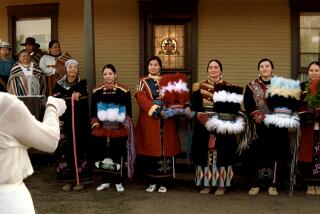Dressing for the Aman Folk Ensemble
- Share via
Barry Glass, who has danced with the Aman Folk Ensemble for nearly 20 years, remembers when finding authentic costumes for the dance and music troupe was easy.
On a trip to Croatia, Yugoslavia, in 1968, “I turned down a complete Croatian woman’s costume for $65, because I knew I could get it cheaper,” he said. “Nowadays, one piece of the outfit, if you could find it, would be in the several hundreds (of dollars).”
Increasing scarcity of traditional native dress hasn’t hindered the company however, Glass said. When the real thing can’t be found, a replica is manufactured. “Dress for Dancing: Costumes From the Aman Folk Ensemble,” an exhibit containing both originals and replicas, opens Wednesday at the Craft and Folk Art Museum.
“Many of these costumes were once worn on a daily basis,” said exhibit curator Laurie Beth Kalb, “but now they are used less and less. The progression goes from everyday dress, to use on ritual occasions or holidays, to appearance in folk life festivals, to use in performances by dance companies and revival groups. Aman is really part of the progression of preserving traditional costumes.”
Thirty complete costumes from Croatia, Macedonia, Egypt, Tunisia, Norway, Mexico and America are featured in the exhibit, organized on the occasion of the Los Angeles-based troupe’s 25th anniversary.
One purpose of the project is to show how the costumes, made of materials ranging from brocade to embroidered homespun to cut velvet, are adapted for Aman’s dancers.
It all has to do with time, said Glass, the company’s artistic director. Performers have precious little time to change costumes between dances. So, skirts and aprons are often basted together to be donned as one piece. Or, where a Croatian woman might place a wooden form atop her head to give her headdresses, affixed separately, a certain shape, Aman dancers attach a simple sponge to the headdress for the same effect with less effort.
“The original costumes are very often quite elaborate and aren’t meant to get into quickly,” Glass said.
“Dress for Dancing,” through April 16, also includes musical instruments used in Aman performances, such as a Thracian bagpipe and a Hungarian-style violin.
GRANTS: The Craft and Folk Art Museum is one of two Los Angeles arts organizations to recently receive major grants from the James Irvine Foundation.
The museum was awarded $100,000 toward the establishment of a Center for Advanced Study of Art, Design and Material Culture. The center, to be housed at the museum, will be an outgrowth of its 12-year-old Library and Media Resource Center.
ARTS Inc., a nonprofit organization providing management-related services to Los Angeles County arts organizations, received $70,000. The majority of the money will be used to expand its Arts Registry database, a comprehensive collection of information about some 800 local arts organizations.
MAKE LOVE TO THE CAMERA: Sit alone in a little room, face a camera and talk about love. That’s what people do who make Love Tapes, short videos produced by Wendy Clarke. The video artist, whose Love Tapes have been shown at New York’s Museum of Modern Art and the USC Atelier, will be inviting the public to make more of the same at Vidiots, 302 Pico Blvd., Santa Monica, today, from 3-9 p.m. Selected Love Tapes from the past 16 years, as well as the newly produced ones, will be screened.
BACKSTAGE VIEW: A tour of 21 artists studios in Palos Verdes and San Pedro will be offered next Sunday by The Circle, the support group of the Palos Verdes Art Center. Ted Twine, Nick Boskovich and Jay McCafferty are among those artists with studios on the 10 a.m.-4 p.m. tour. It will leave from the art center at 5504 W. Crestridge Road, Rancho Palos Verdes. Tickets are $15. Information: (213) 541-2479.
More to Read
The biggest entertainment stories
Get our big stories about Hollywood, film, television, music, arts, culture and more right in your inbox as soon as they publish.
You may occasionally receive promotional content from the Los Angeles Times.










